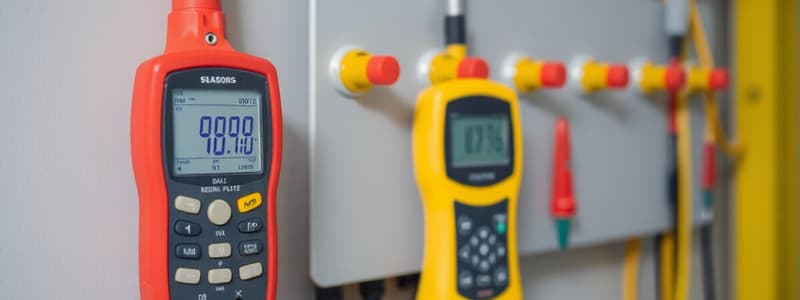Podcast
Questions and Answers
What is the formula for calculating total capacitance in a series circuit?
What is the formula for calculating total capacitance in a series circuit?
- $C_t = 1/(1/C_1 + 1/C_2 + 1/C_3)$
- $C_t = C_1 + C_2 + C_3 + ... + C_n$
- $1/C_t = 1/C_1 + 1/C_2 + 1/C_3 + ... + 1/C_n$ (correct)
- $C_t = C_1 * C_2 * C_3$
What device is primarily used to measure temperature in electrical systems?
What device is primarily used to measure temperature in electrical systems?
- Thermocouple (correct)
- Thermometer
- Inductor
- Transistor
What happens to the severity of electrical shocks as the current increases?
What happens to the severity of electrical shocks as the current increases?
- It decreases and becomes less painful.
- It remains constant regardless of the current.
- It only increases if the exposure time is short.
- It becomes more painful and can lead to loss of muscular control. (correct)
What is the primary cause of electrical fires according to the information provided?
What is the primary cause of electrical fires according to the information provided?
What type of burn is caused by electrical current passing through the tissues?
What type of burn is caused by electrical current passing through the tissues?
What is the relationship between inductance and energy storage in an inductor?
What is the relationship between inductance and energy storage in an inductor?
What class of fire extinguisher is suitable for electrical fires?
What class of fire extinguisher is suitable for electrical fires?
What is an essential safety feature for conveyors that move above workers in a factory?
What is an essential safety feature for conveyors that move above workers in a factory?
Which factor is NOT considered when assessing the environment for materials handling?
Which factor is NOT considered when assessing the environment for materials handling?
What is a precaution to take when using jacks for lifting?
What is a precaution to take when using jacks for lifting?
What hazard is associated with battery-powered vehicles?
What hazard is associated with battery-powered vehicles?
Which of the following practices enhances safety when using hand-operated vehicles?
Which of the following practices enhances safety when using hand-operated vehicles?
What are the four components of communication?
What are the four components of communication?
Which is NOT a priority in effective hazard control?
Which is NOT a priority in effective hazard control?
How can one minimize the severity of hazards?
How can one minimize the severity of hazards?
What is the primary focus of simultaneous time events analysis?
What is the primary focus of simultaneous time events analysis?
Which action can help in recognizing or anticipating hazards?
Which action can help in recognizing or anticipating hazards?
What is an example of reducing the probability of occurrence of a hazard?
What is an example of reducing the probability of occurrence of a hazard?
What does fault tree analysis primarily aim to achieve?
What does fault tree analysis primarily aim to achieve?
What kind of logic does fault tree analysis utilize?
What kind of logic does fault tree analysis utilize?
Which of the following is NOT a means to control hazards?
Which of the following is NOT a means to control hazards?
What is a key limitation of fault tree analysis?
What is a key limitation of fault tree analysis?
What is the purpose of redundancy in a system?
What is the purpose of redundancy in a system?
How does a sprinkler system function regarding fire hazards?
How does a sprinkler system function regarding fire hazards?
What is the main purpose of a hazard and operability study?
What is the main purpose of a hazard and operability study?
Which action helps in assigning responsibility for preventive actions?
Which action helps in assigning responsibility for preventive actions?
What does failure modes and effects analysis assess?
What does failure modes and effects analysis assess?
What is a characteristic of what-if analysis?
What is a characteristic of what-if analysis?
What might introduce hazards in a workplace?
What might introduce hazards in a workplace?
Who should be part of the team conducting the process hazard analysis?
Who should be part of the team conducting the process hazard analysis?
What does the house shape symbolize in fault tree analysis?
What does the house shape symbolize in fault tree analysis?
What is the minimum requirement for refresher training for team members involved in analysis?
What is the minimum requirement for refresher training for team members involved in analysis?
What is the primary purpose of an emergency stop control?
What is the primary purpose of an emergency stop control?
What characteristic is typical of emergency stop controls?
What characteristic is typical of emergency stop controls?
What safeguard should be incorporated into a machine to prevent unintended extra cycles?
What safeguard should be incorporated into a machine to prevent unintended extra cycles?
How quickly can electronic motor brakes typically stop rotary motion after power is off?
How quickly can electronic motor brakes typically stop rotary motion after power is off?
What is the primary function of jog controls?
What is the primary function of jog controls?
What does an anti-kickback device do in a circular saw?
What does an anti-kickback device do in a circular saw?
Which devices are considered safeguards for robots?
Which devices are considered safeguards for robots?
When multiple operators are present, what is necessary for safety concerning emergency stop controls?
When multiple operators are present, what is necessary for safety concerning emergency stop controls?
Which feature helps to enhance safety during cleaning or maintenance of machines?
Which feature helps to enhance safety during cleaning or maintenance of machines?
Flashcards
Capacitance in a Series Circuit
Capacitance in a Series Circuit
The total capacitance of capacitors connected in series is calculated as the reciprocal of the sum of the reciprocals of individual capacitances.
Capacitance in a Parallel Circuit
Capacitance in a Parallel Circuit
The total capacitance of capacitors connected in parallel is calculated as the sum of individual capacitances.
Oscillators
Oscillators
Electronic circuits that generate high-frequency alternating currents. Oscillators are crucial for creating signals in radios, clocks, and other devices.
Thermocouple
Thermocouple
Signup and view all the flashcards
Inductors
Inductors
Signup and view all the flashcards
Electrical Shock Hazard
Electrical Shock Hazard
Signup and view all the flashcards
Electrical Fires
Electrical Fires
Signup and view all the flashcards
Emergency Stop Control
Emergency Stop Control
Signup and view all the flashcards
Anti-repeat Mechanism
Anti-repeat Mechanism
Signup and view all the flashcards
Electronic Motor Brake
Electronic Motor Brake
Signup and view all the flashcards
Jog Control
Jog Control
Signup and view all the flashcards
Anti-kickback Device
Anti-kickback Device
Signup and view all the flashcards
Anti-kickback Dog/Splitter
Anti-kickback Dog/Splitter
Signup and view all the flashcards
Anti-Kickback Fingers
Anti-Kickback Fingers
Signup and view all the flashcards
Robots
Robots
Signup and view all the flashcards
Robot Safeguard Devices
Robot Safeguard Devices
Signup and view all the flashcards
Communication Process
Communication Process
Signup and view all the flashcards
Hazard
Hazard
Signup and view all the flashcards
Hazard Control
Hazard Control
Signup and view all the flashcards
Communication of Changes
Communication of Changes
Signup and view all the flashcards
Hazard Reduction
Hazard Reduction
Signup and view all the flashcards
Hazard Severity Reduction
Hazard Severity Reduction
Signup and view all the flashcards
Probability of Occurrence Reduction
Probability of Occurrence Reduction
Signup and view all the flashcards
Redundancy System
Redundancy System
Signup and view all the flashcards
Flammable Material Storage
Flammable Material Storage
Signup and view all the flashcards
Historical Data for Hazard Identification
Historical Data for Hazard Identification
Signup and view all the flashcards
Safe Load Limits
Safe Load Limits
Signup and view all the flashcards
Overhead Protection
Overhead Protection
Signup and view all the flashcards
Training for Operators
Training for Operators
Signup and view all the flashcards
Jack Safety
Jack Safety
Signup and view all the flashcards
Hand-Operated Vehicle Safety
Hand-Operated Vehicle Safety
Signup and view all the flashcards
Failure Modes and Effects Analysis (FMEA)
Failure Modes and Effects Analysis (FMEA)
Signup and view all the flashcards
Failure Modes and Effects Analysis (FMEA)
Failure Modes and Effects Analysis (FMEA)
Signup and view all the flashcards
Fault Tree Analysis (FTA)
Fault Tree Analysis (FTA)
Signup and view all the flashcards
Simultaneous Time Events Analysis
Simultaneous Time Events Analysis
Signup and view all the flashcards
What-If Analysis
What-If Analysis
Signup and view all the flashcards
Hazard and Operability Study (HAZOP)
Hazard and Operability Study (HAZOP)
Signup and view all the flashcards
Process Hazard Analysis (PHA)
Process Hazard Analysis (PHA)
Signup and view all the flashcards
House Shape in FTA
House Shape in FTA
Signup and view all the flashcards
OR Logic Gate in FTA
OR Logic Gate in FTA
Signup and view all the flashcards
AND Logic Gate in FTA
AND Logic Gate in FTA
Signup and view all the flashcards
Study Notes
Electrical Basics
- Voltage is the difference in charge between two points.
- Current is the rate of charge flow.
- Resistance is a material's tendency to oppose current flow.
- Ohm's Law: V = I x R (V = volts, I = amperes, R = ohms)
- 1 Amp = 1 Coulomb
Series Circuits
- Components are connected along a single path, resulting in the same current flowing through each component.
- Resistance is additive: Rseries = R1 + R2 + ...+ Rn
Parallel Circuits
- Current branches to each component, and the voltage across each component is the same.
- Reciprocal of resistance is additive: 1/Rparallel = 1/R1 + 1/R2 + ... + 1/Rn
Direct Current (DC)
- Unidirectional flow of charge.
- Current flows constantly in one direction.
Alternating Current (AC)
- Charge periodically reverses direction.
- Current flow alternates between positive and negative values.
Resistance
- Series circuit resistance: Rseries = R1 + R2 + ...+ Rn
- Parallel circuit resistance: 1/Rparallel = 1/R1 + 1/R2 + ... + 1/Rn
Voltage in AC Circuits
- V= √PI/CosФ (V = voltage, I = impedance, φ = phase angle in degrees)
- P = true power
Power in DC circuits
- P= VI
- P= I2R = V2/R
Capacitors
- Passive components storing energy in an electric field.
- Capacitance values measured in Farads (F).
- Series capacitance: 1/Cseries = 1/C1 + 1/C2 + 1/C3..+1/Cn
- Parallel capacitance: Cparallel = C1 + C2 + ... Cn
Inductors
- Passive components storing energy in a magnetic field.
- Inductance measured in Henries (H).
- Inductance in a circuit depends on its physical characteristics.
Electrical Shock Hazards
- Current and duration affecting body resistance.
- 5 mA: Slight shock, no pain.
- 6–25 mA: Painful shock, loss of control.
- 50–150 mA: Freezing current, inability to release.
-
75 mA possible ventricular fibrillation.
Types of Burns
- Electrical burn can range to deep tissue and bones.
- Arc burns cause high heat lead to burns and clothing.
- Thermal contact burns to skin from direct contact.
Explosions
- Defective or misused electrical equipment.
Power lines
- Workers should keep a safe distance.
- Avoid working near live wires.
Studying That Suits You
Use AI to generate personalized quizzes and flashcards to suit your learning preferences.
Related Documents
Description
This quiz tests your knowledge on electrical safety principles, measurement devices, and best practices for working with electrical systems. From understanding capacitance in series circuits to recognizing hazards associated with electrical equipment, it covers essential safety topics. Perfect for students and professionals in electrical engineering fields.





